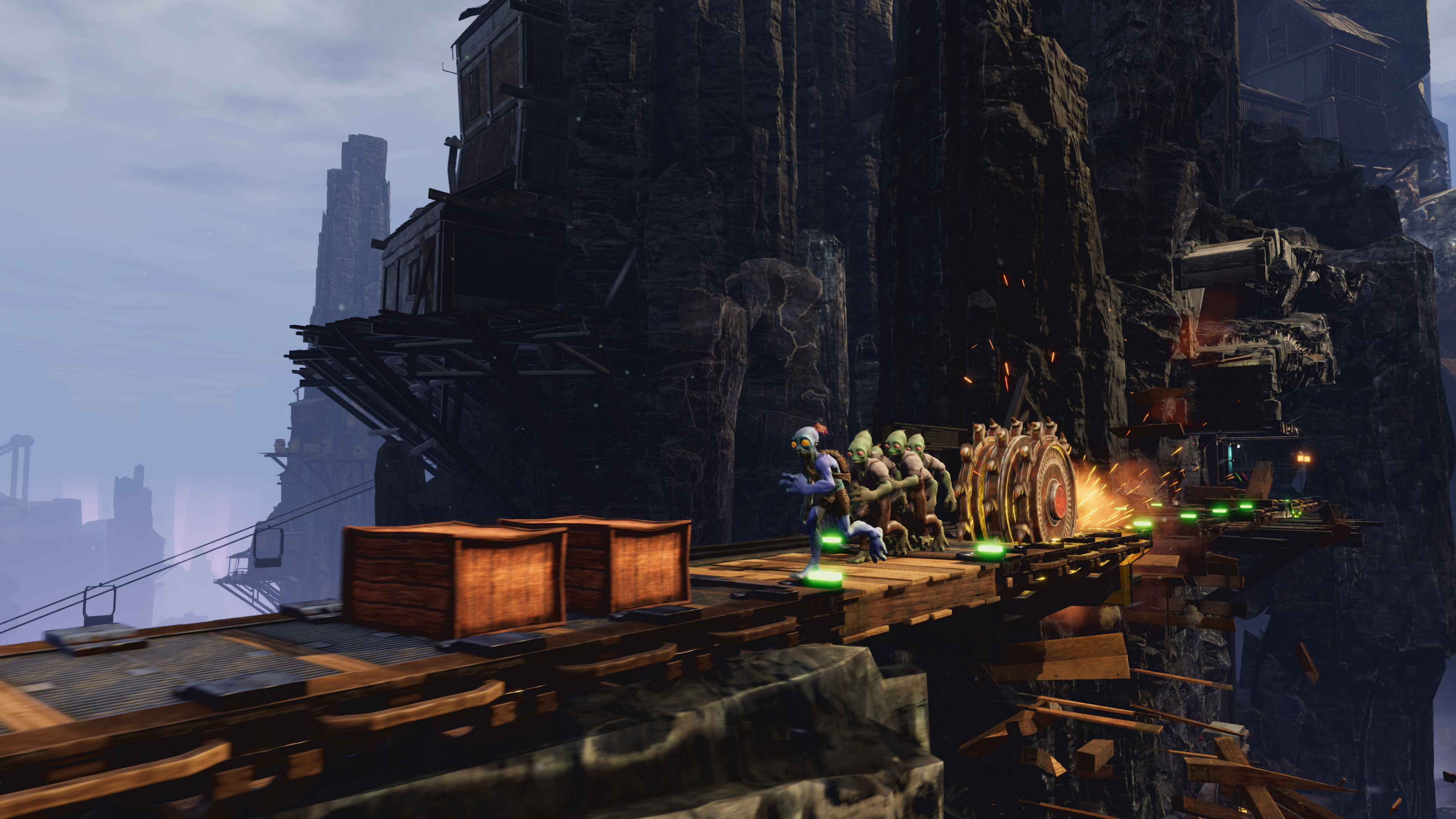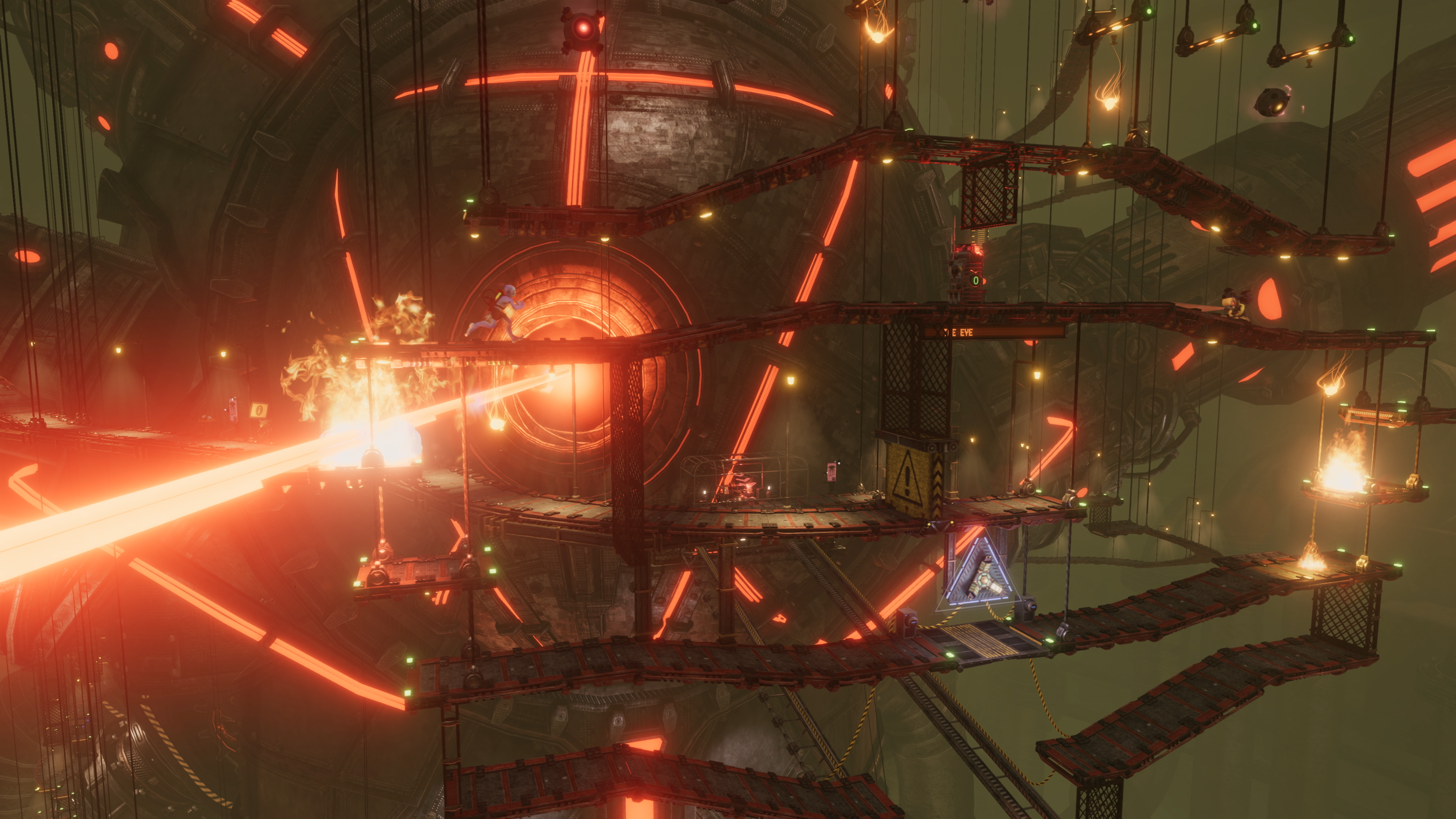Abe is back and chanting, sneaking, and chugging in clearer detail than ever before, in what is assuredly the highest fidelity Oddworld adventure ever presented. Oddworld: Soulstorm reinvents and reimagines Oddworld: Abe’s Exodus for a new era, taking what was originally a somewhat hastily produced sequel and giving it the proper treatment of fleshing out its ideas, mechanics, and story to create a richer experience. While the promise of Soulstorm is grand in theory, in practice it hews a little too closely to its roots, with the gameplay often failing to match the generous updates that have been received in practically every other department. The result is a disjointed experience which looks entirely new and fresh, but still feels mired in its own legacy.

Oddworld: Soulstorm picks up shortly after the ending of New and Tasty, with Abe and his fellow Mudokons enjoying their newfound freedom and safety in the refuge of a lovely cave. While his peers celebrate him and his heroics, Abe is having experiencing a massive case of imposter syndrome and wants nothing more than to flee his newfound role as a hero in favor of slinking off somewhere quiet to live peacefully and away from the spotlight. As fate would have it, Molluck the Glukkon and his army of Sligs descend upon their hideaway seeking vengeance pretty much immediately, forcing Abe back into the role of the reluctant hero. It’s an old trope, but one that fits the character’s meek persona.
And so, Soulstorm kicks off its journey, introducing you to its systems and familiarizing you with the act of controlling Abe in what has all the hallmarks of being a brilliant refresh in the opening minutes. Soulstorm shows off its visuals in grand fashion during this prolonged escape sequence, and truthfully it’s a very pretty game, especially for a sidescroller. There’s been some clever work done with the level designs so that even though your perspective is side-on, the geometry itself weaves and winds its way through the landscape as you progress through each “screen,” giving you the sense that this is indeed part of a larger environment.

Materials and textures are sharp and the lighting is generally pretty good, though the environment layouts do have the feel of being built from a large library of prefab parts, which is fine and even expected, but something about the way everything is pieced together makes the seams and the reusable nature of its pieces obvious to the extent that I often found myself paying too much attention to the elements on the screen rather than the actual layout. To be fair, this becomes less of a problem in some of the later levels, but early on in the game or in locales that are supposed to be more “natural,” the effect is generally more obvious.
That all fades away pretty quickly as you start tossing fire bombs and flammable bottles of booze around, using the various tools at your disposal to cause significant bodily harm to the unsavory Slig patrols that are out to recapture and/or murder Abe. Success in Soulstorm is about studying the layout of the screen you’re on, creating a plan to move through it, and executing on that plan. While there is a temptation to look at Oddworld games and assume they are pure action platformers (and try to play them that way), the reality is they’re puzzle games first and foremost, and you’ll get punished brutally if you don’t play them as such.

Abe is by all accounts a weak hero, relying on his own wits and exploitation of things around him to make his way forward. You often have a variety of tools at your disposal to make forward progress, but often times the game forces you into a particular method to get through a sequence by disabling your abilities or some other such mechanic that requires you to engage with its stealth and platforming mechanics in ways that can frankly be really frustrating, because I don’t feel either of those aspects are particularly strong. Controlling Abe is fine for the most part, but the stealth sequences in general require a degree of precision that Abe often doesn’t feel capable of, and the way stealth works in Soulstorm honestly leaves a lot to be desired for me.
My standards for stealth are pretty specific; I’ve been living on a healthy diet of Metal Gear Solid for a good 23 years now, and so I’m conditioned to favor mechanics that challenge the player, but give you more than sufficient control to outmaneuver and outsmart your foes. There are plenty of games that do stealth well; look at the Arkham series of Batman games, Marvel’s Spider-Man, Hitman, Dishonored, Deus Ex… I could go on. The point is that each of these games requires you to be quiet and unseen while embedded deep within hostile territory, but each of them leaves you feeling empowered to overcome those challenges.

When it comes to Soulstorm, it feels like Abe is barely capable of moving from one hiding spot to the next during brief windows of enemy vision cones being cast away from him, and this is further complicated by the fact that running or too-fast movement will still trigger an alert because of the sound his footsteps make. Unsurprisingly, the result is a whole lot of trial and error, to the point of minor frustration and feeling like I’m frequently fighting against the game despite doing what it asks. I don’t feel empowered, I feel incapable, or barely capable, and often getting through these sections leaves me not with a sense of accomplishment so much as relief at being able to move on. Until the next screen shows up with similar conditions and I have to choose whether to keep going or save and quit for another day.
Soulstorm is a game of thin margins; your timing windows for successful sneaking are small, the hitboxes on landmines are frustratingly difficult to navigate (as are their timing windows for disarming), and nearly every part of the game that asks you to do something with precision feels like playing Operation with a slightly oversized set of tweezers. Soulstorm expects a lot of you, and Abe is just a little too clunky to move, and a little too limited in his capabilities to meet those expectations without a whole lot of trial and error, which is an exercise I frankly do not have time or patience for when it’s such a frequent occurrence, and when so much of that error feels like its beyond my control.

Perhaps the most disappointing part of Oddworld: Soulstorm for me is that it has so many great ideas, and so much going for it that feels fun and exciting out the gate. I truly want to like Soulstorm a lot, and I feel like it’s not that far off from being a better game. Its difficulty curve feels a little too steep too early, though, and playing it feels too much like playing a game from the late 90s for me to be able to get there. While it’s understandable that Oddworld Inhabitants would want this game to feel “true” to its source material, the game’s mechanics are simply dissonant with the major updates and upgrades every other part of the game has received. Updates and remasters that work well know how to make important changes so that a game feels good to play by today’s standards while still “feeling” true to the original.

Perhaps the whole point of the Oddworld games is that they’re supposed to be difficult. Perhaps the fun is supposed to be derived from overcoming seemingly impossible odds, even if it means beating your head against the wall too many times to get there. Unfortunately, this kind of fun feels dated and cumbersome to me, which is particularly hard to rationalize against the backdrop of an otherwise loving and carefully crafted re-imagining of a beloved entry in a beloved series. I expect the die hard fans will enjoy Soulstorm a great deal, and I’m really happy for them that this game exists. Speaking as a longtime admirer of the series who was hoping to finally be won over completely, I’m still left waiting for that magic moment.
An Epic Games Store code was provided by the publisher for review purposes
